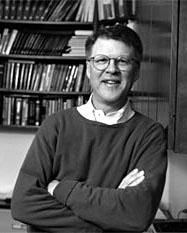Published: September 2007
A pioneer in the field of organic chemistry, Peter Dervan ’67, Bren Professor of Chemistry at the California Institute of Technology, was honored at a White House ceremony on July 27 as one of eight recipients of the 2006 National Medal of Science, the nation’s highest recognition of scientific achievement. For Dervan, who began teaching at Caltech in 1973, the medal is the most recent of 28 major awards and fellowships (over and above his honorary Doctor of Science degree from Boston College in 1997). He was named a Guggenheim Fellow, received the Linus Pauling Medal, was named to the American Academy of Arts and Sciences, and was three times voted by students to receive Caltech’s annual award for teaching excellence.
Throughout his career Dervan has focused on understanding the chemical principles for the sequence-specific recognition of DNA. “I became interested in creating novel molecular shapes with properties different from those found in nature shortly after arriving at Caltech in 1973,” Dervan wrote in the 2001 issue of Bioorganic and Medicinal Chemistry. “I asked the question whether organic chemists could rationally create ‘four chemical keys’ which would distinguish each of the Watson-Crick base pairs and, when linked together, read any continuous predetermined sequence of DNA.” His accomplishments could have profound implications for human medicine, such as synthesizing new classes of anti-infectives and blocking the growth of cancer cells using “transcription therapy.”
Teaching and ongoing research as head of the Caltech’s “Dervan Group” provide “intellectual vitality and excitement,” he writes. “Synthetic organic chemistry is one of the most powerful tools in modern science and, in the post-genome world, organic chemists will continue to play a major role.”
- Home page of the Dervan Group
- Article by Peter Dervan in Bioorganic & Medicinal Chemistry 9 (2001), describing the development of his work
- News of Dervan’s award on the Chemistry Department’s web page
- Awards ceremony at the White House, including both text and video of the proceedings
- National Science Foundation web page for the National Medals of Science.”

